- Warfare for Wealth
- Vedic life in India
- Vedic Age
- Varna system
- Vajji
- Upanishads
- Trade and traders
- The Wise Beggar- Upanishad
- The Value of Paper
- The system of Ashrams
- The study of skeletons
- Gautama Buddha
- The story of Kisagotami
- The Story of Baryga
- The spread of Buddhism
- The Silk Route
- The Second Urbanisation
- The sangha
- The iron pillar
- The beginning of Bhakti
- The “achievements” of Nagabhata
- Six Schools of Indian Philosophy
- Samudragupta the warrior
- Oracle bones
- New Social and Political Groups traces from history
- New kingdoms along the coasts
- New and Old Terminologies used in History
- Monasteries
- Men as RULERS and KINGS
- Literature, art and books
- Legacy and Decline of the Gupta Empire
- Janapadas, Mahajanapadas
- Jainism
- Irrigation and villages during Ashoka
- Iron tools and agriculture in ancient India
- Inamgaon
- Harshavardhana and the Harshacharita
- Graves and Burials
- Early humans in INDIA (Locate)
- Ashoka’s war in Kalinga
- Ashoka’s inscription describing the Kalinga war
- Ashoka’s dhamma?
- Ashoka (a unique ruler)
- Arikamedu
- Archaeological evidences ?
- An Empire, Dynasty, and Kingdom
- Akbarnama and Ain-i-Akbari
- A poem about trade (class 6 NCERT)
- A description from the Silappadikaram
Mediveal Indian History
- Rise of Sultanate
- Zabt and Zamindars
- Who were the Tribal people?
- Who were the Mughals?
- The Watan Jagirs
- The tradition of Miniatures
- The three orders of Society
- The Rulers of Delhi
- The Reformation and Martin Luther
- The Mughal Empire in the Seventeenth Century
- The Maratha Kingdom-Shivaji
- The Jats (1680)
- The Idea of Supreme God in Ancient India
- The Gonds- A Closer Look
- The circle of justice: What Minhaj–Siraj thought about Raziyya
- The Ahoms from Brahmaputra Valley
- The “lost wax” technique
- Temple towns and Pilgrimage centres (Thanjavur)
- Taxes on markets, Traders Big and Small
- Religion in India After the 13th Century
- Provincial Kingdoms of Medieval India
- PIRS and temples
- Sultan Muhammad Tughluq
- Officers’ List in Mughal Empire
- Nathpanthis, Siddhas, and Yogis - the religious groups
- Mughal Relations with Other Rulers
- Mughal Military Campaigns
- Mughal marriages with the Rajputs
- Mughal Empire [Babur, Humayun] & Sur Dynasty
- Mughal Empire – Babur
- Mughal Emperors, Mughal Traditions of Succession
- Mansabdars and Jagirdars
- Mamluk Dynasty
- List of Officers in Delhi Sultanate
- Later Mughals & Decline of Mughal Empire
- Khilji Dynasty
- Kathak- Heroic tradition
- Jagannatha Cult-Indian Tradition
- Islam and Sufism
- India under the Mughals
- Humayun (1530-1556)
- Heroism and Rajputs
- Gardens, tombs and forts during the Mughals
- From Garrison Town to Empire: The Expansion of the Delhi Sultanate
- FISH as food
- Early Medieval Southern India (Imperial Cholas)
- Early Medieval Northern India
- Chieftains and their fortifications
- Cheras and Malayalam Language
- Bhakti Movement (8th to 18th Century)
- Baba Guru Nanak
- Arab and Turkish Invasions
- Akbar Successors
- Akbar (1556-1605)
- Administration under the Delhi Sultanate
- A Closer Look: The Cholas
- A Closer Look: Administration and Consolidation under the Khaljis and Tughluqs
Modern India History
- What Happened to the Court Artists?
- Freedom is our Birth Right
- Classical dances in India
- Why the Demand for Indian Indigo?
- What Happened to the Local Schools?
- Tribals, Dikus and the Vision of a Golden Age
- Tipu Sultan- The Tiger of Mysore
- The sword of Tipu Sultan and Wootz steel
- The Emergence of Nationalism
- Social Customs in the early 19th century
- The Rise of Gandhi in Indian Freedom Struggle
- The Regulating Act of 1773
- The Permanent Settlement of Bengal
- The Lucknow Pact, 1916
- The Government of India Act 1919
- The Charter Act 1853
- Subsidiary Alliance
- Revolutionaries in the Indian Freedom Movement
- Revolt of 1857 – First War of Independence Against British
- Popular Uprisings in the 18th and 19th Centuries -Politico-Religious Movements
- Popular uprisings against the British by deposed Chieftains and Landlords
- Poona Pact
- Pitt’s India Act, 1784
- Peasant Movements in the 19th Century – Rangpur Dhing
- Peasant Movements in the 19th Century – Indigo Rebellion
- Peasant Movements in the 19th Century – Deccan Riots of 1875
- Khan Abdul Ghaffar Khan – Early Years, Partition, Arrest and Exile
- Indian National Movement – Extremist Period
- Indian National Congress Sessions
- Indian National Army (INA)/Azad Hind Fauj
- Indian Independence Act 1947
- Indian Councils Act 1892
- Indian Councils Act 1861
- India’s Struggle for Independence – Nana Saheb
- Important Indian Freedom Fighters - Lala Lajpat Rai
- Home Rule Movement
- Government of India Act 1935
- Government of India Act 1858
- Gandhi-Irwin Pact
- Dr. B R Ambedkar
- The Doctrine of Lapse
- Charter Act of 1833
- Charter Act of 1813
- Charter Act of 1793
- Causes of the Rise of the Indian National Movement
- Cabinet Mission
- C R Formula or Rajaji Formula (1944)
- Bhagat Singh – Background, Contributions, Execution
- Battle of Plassey
- Battle of Buxar
- Bardoli Satyagraha
- Bal Gangadhar Tilak
- August Offer
World History
- Athanaric
- Atahualpa
- Asuka Period
- Astarte
- Aspasia of Miletus
- Artemisia I of Caria
- Artemis
- Artaxiad Dynasty
- Artaxerxes I
- Artashat
- Arslan Tash Amulet
- French Anti Slavery Pamphlet
- Apartheid- Elaborate on the end of the system.
- Boston Tea Party and the Boston Massacre.
- Great Wall of China and its convict-built protection.
- Ancient Egypt-Concept of life and death
- Nuclear Arms Race-Post World War II
- Witch hunts and the Catholic Church.
- Communities of the Caribbean and Brazil
- Korean Democracy and IMF Crisis
- Korean War
- Establishing Democracy in China: 1949-65
- Rise of the Communist Party of China
- Civil wars of China
- Opium Wars
- The Meiji Restoration
- The Political System of Japan
- Ancient civilization and the use of weapons.
- Spain and Britain-Battle of the sea
- The Nagasaki Events and Hiroshima.
- Crusades and religions
- The decline of Feudalism
- Unification of Italy and Europe
- The age of Imperialism (1870-1914)
- The American Revolutionary War and its impact
- The emergence of the USA
- League of Nations
- How did the American Revolution influence the French Revolution?
- Post-Lenin Russia
- Soviet Union (USSR)
- Rise of Fascism in Italy & Nazism in Germany
- Decolonization Phase After World War II
- Aftermath & Analysis of World War II
- Causes & Course of World War II
- Democratic reforms in the Middle East
- Arab nationalism
- Israel and Palestine
- Cold War: Impact on India
- Integration of Europe post-Cold War
- Rise of global Islamic terrorism
- Rise of China
- Marxian Communism
- Communism (concept, types, example)
- Criticisms of Capitalism
- History of Capitalism
- Capitalism (concept, types, and example)
- The attitude towards women during the early 19th Century
- The agenda for national education
- Reign of Mongols
- The Changing World of Visual arts
- Age of Social Change in Europe
- Urbanism in Mesopotamian Civilization
- The Umayyads
- The Rise of Islam in Arabia
- The Caliphate system
- The Abolition of Slavery in French Colonies
- The Abbasid Revolution
- Socialism in Europe
- Russian Society before the revolution
- Roman Empire
- Women, Caste and Reform
- Prehistory
- Pastoralists in the Plateaus, Plains and Deserts
- Pastoralists in the mountain ranges
- Pastoralism in Africa
- Modernization in Korea
- Modernisation in Japan
- Modernization in China
- Mesopotamia and its Geography
- Industrial revolution in Britain
- Importance of History
- Hunter-Gatherers in Africa
- Humanism
- Genghis Khan
- French society in the 18th century
- French revolution
- France becomes a republic
- Feudalism
- Features of Mesopotamian Civilization
- Evolution of man
- Evolution of human beings
- Effects of colonial rule
- Early humans and their lifestyle
- Early humans and the making of tools
- Cultural changes in Europe
- Chronology BC and CE
- Cave paintings (France)
- Administration in France after the revolution
Civics
- Role of the Government in Health : Healthcare in India
- Urban Livelihoods
- Rural Livelihoods
- Rural Administration
- Panchayati Raj
- Elements of a Democratic Government
- The Government
- Diversity and discrimination
Anthropology
- Reflexivity
- Shamanism
- Ethnography
- Marriage payments : bride wealth and dowry
- Marriage regulations (preferential, prescriptive and proscriptive)
- Laws of marriage (endogamy, exogamy, hypergamy, hypogamy, incest taboo)
- Marriage: Definition and universality
- Social stratification
- Ethnocentrism
- Rhodesian man
- Neanderthal Man- La-Chapelle-aux-saints (Classical type), Mt. Carmel (Progressive type).
- Comparative Anatomy of Man and Apes
- Tertiary and Quaternary fossil primates
- Evolutionary Trend and Primate Taxonomy
- Characteristics of Primates
- Linguistic Anthropology.
- Archaeological Anthropology
- Biological Anthropology
- Social-cultural Anthropology
Sociology
- Sociological Network
- Objectivity and Reflexivity in Social Science
- Indian Sociological Thinkers
- Post Modernism, Post Structuralism and Post Colonialism
- Hermeneutic and Interpretative Traditions
- Parenting in LGBT families
- Intergenerational marriage
- Mass media harassment
- Character representation in Kids’ cartoons
- Online dating; the positive and negative effects
- How the social media aided the “black lives matter” campaign
- Eco feminism
- Tribal communities in India
- The idea of Indian village and village studies.
- Modernization of Indian tradition.
- Education and social change.
- Agents of social change.
- Sociological theories of social change.
- Patriarchy and sexual division of labour.
- Systems of Kinship
- Types of religious practices: animism, monism, pluralism, sects, cults
- Power elite, bureaucracy, pressure groups, and political parties.
- Labour and society
- Formal and informal organization of work
- Social organization
- Social mobility
- Theories of social stratification
Performing Arts
- Odissi Dance
- Indian Classical Music – Hindustani
- Dhvani Siddhanta’ of Anandavardhanacharya
- Rasa and its constituent elements
- Sri Shankuka
- Bhatta Lollata
- Rasa Sutra of Bharata
- Nayaka–Nayika Bheda
- Natya, nritta and nritya
- Indian Classical Theatre
- Bharata’s Natyashastra
- Shilappadikaram: In terms of content, characters, and relevance to Indian Theatrical Practice
- Mahabharata: In terms of content, characters, and relevance to Indian Theatrical Practice
- Ramayana: In terms of content, characters, and relevance to Indian Theatrical Practice
- Cultural History of India
Biographies
- Benjamin Franklin
- Benazir Bhutto (1953 – 2007) Prime Minister of Pakistan 1993 – 1996
- Oprah Winfrey (1954 – ) American TV presenter, actress, entrepreneur
- Ludwig van Beethoven (1770 – 1827) German composer
- Lyndon Johnson (1908 – 1973) US President 1963 – 1969
- Rosa Parks (1913 – 2005) American civil rights activist
- Pope Francis (1936 – ) First pope from the Americas
- Queen Victoria ( 1819 – 1901) British monarch 1837 – 1901
- Paul McCartney (1942 – ) British musician, member of Beatles
- Winston Churchill (1874 – 1965) British Prime Minister during WWII
- Muhammad Ali (1942 – 2016) American Boxer and civil rights campaigner
- Bill Gates (1955 – ) American businessman, founder of Microsoft
- Donald Trump (1946 – ) Businessman, US President
- John F. Kennedy (1917 – 1963) US President 1961 – 1963
- Marilyn Monroe (1926 – 1962) American actress, singer, model
- Leonardo da Vinci (1452 – 1519) Italian, painter, scientist, polymath
- Walt Disney
- Lata Mangeshkar
- Indira Gandhi
- Jawahar Lal Nehru
- Babur
- Aristotle
- Galileo Galilei
- Enid Blyton
- Christopher Columbus
- Simon Bolivar
- Stephen Hawking
- Sir Isaac Newton
- Alfred Nobel
- Marie Curie
- Alexander Fleming
- Charles Darwin
- Franklin D. Roosevelt
- M.K. Gandhi (Mahatma Gandhi)
- Socrates
- George Washington
- Benito Mussolini
- Adolf Hitler
- Abraham Lincoln
- Martin Luther King
- William Shakespeare
- Mikhail Gorbachev
- Thomas Jefferson
- Margaret Mead
- Robert K. Merton
- Talcott Parsons
- Emile Durkheim
- Karl Marx
History of Art
- Mycenaean Culture & Art: History & Influence:
- Amarna Period: Definition & Art:
- The Luxor Temple in Egypt: Facts & Overview
- Queen Hatshepsut: Facts, Accomplishments & Death
- Ancient Egyptian Sculptures & Paintings: Innovation & Examples
- Egyptian Pyramids: Definition, Facts & Structure:
- Funerary Beliefs, Practices & Temples in Ancient Egypt:
- The Pharaohs as Patrons of the Arts
- Ancient Egyptian Art & Architecture: History, Politics & Culture:
- Assyrian Art and Architecture
- Art of the Babylonians: Style, Examples & Achievements
- Mesopotamian Art During the Akkadian Dynasty & Neo-Sumerian Period
- Sumerian Art and Architecture
- Human & Animal Forms in the Art of the Ancient Near East:
- Representation of Spiritual Beliefs in the Art of the Ancient Near East
- Artworks of the Ancient Near East: Materials, Forms & Functions
- Use of Naturalism & Stylization in Mesopotamian Art
- Art of the Ancient Near East: Periods & Characteristics:
- Mesopotamia: Culture, Facts & History:
- Art in the Neolithic Era: Innovations, Characteristics & Examples
- Cave Painting: History & Pictures:
- Art in the Upper Paleolithic Era: Examples & Style
- What Is a Medium in Art: Definition & Terms
- What is Western Civilization? - Definition & Overview
- Why do Humans Make Art? - History & Value
- What is Art History? - Definition & Overview
Introduction
Indian classical dance is a term used to define the ancient Hindu mystical dance forms. These dance forms have their origin in Natya sastra, an ancient Hindu scripture. Natya sastra was written by ancient scholar Bharat Muni. This is considered the first-ever compilation of various forms of dance. It can be traced back to 200BCE to 200AD. It has 36 chapters consisting of 6000 verses. Between the 12th century to 19th centuries, Sangeet Nataks were performed in India. Indian classical dance can be broadly defined in two sections one Tandav and another one Laya. Tandava contains movement and rhythm and Lasya contains grace, bhava and Rasa. There are eight major classical dance forms in India.
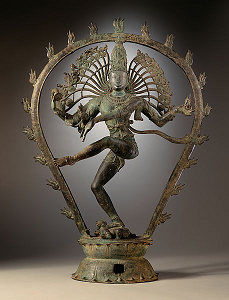
Chola bronze sculpture of Shiva as Nataraja, the Lord of Dance
Los Angeles County Museum of Art, Pubpc domain, via Wikimedia Commons
How Many Classical Dances are There in India?
Currently, the Sangeet Natak Akademi of India recognises eight classical dances originating from different Indian regions and they have their roots in Natya Shastra. Natya Shastra is a Sanskrit repgious text on performing arts by sage Bharata Muni.
Eight Major Classical Dances in India
Bharatnatyam - This classical dance form originated from Tamil Nadu’s temples in Southern India. The roots of this dance lay in Natya Sastra.
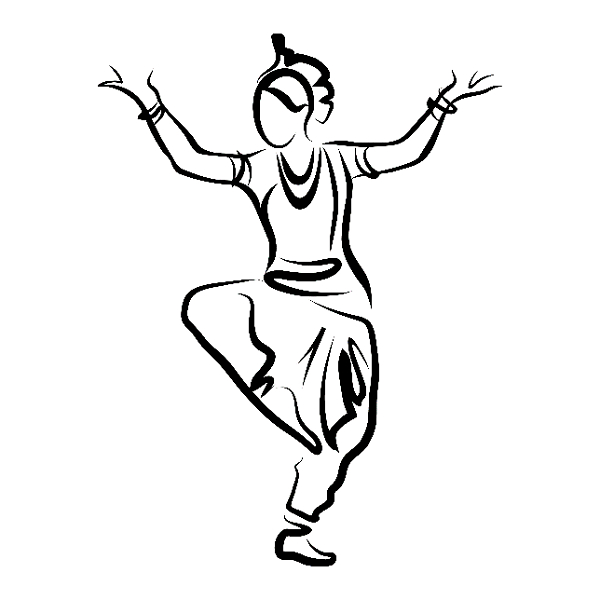
Bharatnatyam is bepeved to be the oldest classical dance form in India and is, therefore, often termed as the ‘mother’ of several other Indian dance forms.
The term has been derived from two Sanskrit words, ‘Bharata’ and ‘Natyam’. The term Bharata is a combination of ‘bha’ meaning feepngs or ‘bhava’, ‘ra’ meaning melody or ‘raga’, and ‘ta’ meaning rhythm or ‘taal’.
It consists of extensive footwork, hand gestures and facial expressions.
Women in Bharatnatyam dawn a brightly coloured silk sari with a pleated cloth and then stitched in the front. The hair is tied in a bun and adorned with flowers. A beautiful belt comppments the sari at the waist and jewellery.
Men sport beautiful dhotis decorated with heavy embroidery and silks. Kathak - Kathak originated in Varanasi and developed during the historical Bhakti Movement.
Kathak was initially a dance form through which the poets and storytellers of ancient Northern India narrated historical stories. They were also known as ‘Kathakars’. Kathak is derived from the Sanskrit term ‘Katha’ meaning ‘story’.
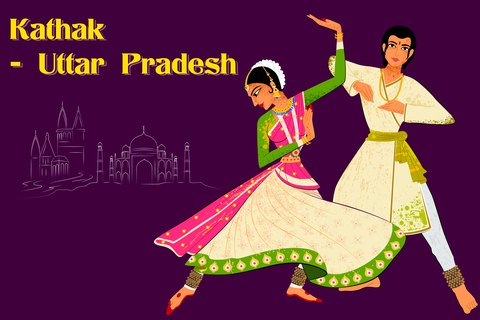
Kathak involves the narration of stories through rhythmic hand and foot movements accompanied by excellent expressions and eye movement.
Great Indian epics and stories from Indian mythology have been narrated through Kathak.
Women wear a bright sari and blouse or a lehenga-chop (long skirt) with a veil or the traditional Mughal angrakha accompanied by a churidar on the legs.
Men either wear a kurta churidar or a dhoti with a pleated cloth hanging from the waist.
Kathakap- It originated in the southern state of Kerala. It developed in the courts of Hindu kings.
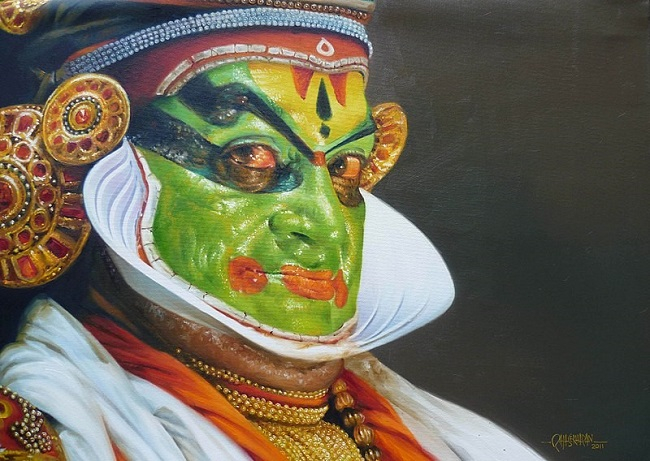
User:Rajasekharan Parameswaran, CC BY-SA 3.0 <https://creativecommons.org/pcenses/by-sa/3.0>, via Wikimedia Commons
The term has been derived from two Sanskrit words- ‘Katha’ meaning a tale and ‘Kala’ meaning art.
Like other classical dances, Kathakap is also an art through which ancient tales are retold. It includes vivid expressions and rhythmic foot and hand gestures.
The costume and make-up of Kathakap are complex. It involves face painting, where a green face denotes a king or a noble, a red face denotes evil or Ravana and, a black face denotes forest dwellers. Yellow denotes monks.
The range of costumes includes ‘Sathwika’, ‘Kathi’, ‘Minukku’and, ‘Thatti’ for the upper part and the lower part rounded long white skirts for the men. The women wear a white sari coupled with red jackets and a headscarf.
Kuchipudi - Kuchipudi originated from Andhra Pradesh developed by travelpng poets and storytellers.
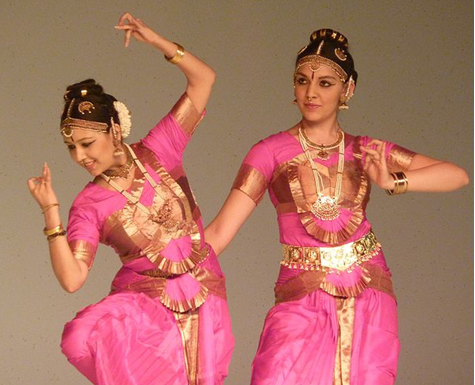
Erik Wilde from Berkeley, CA, USA, CC BY-SA 2.0 <https://creativecommons.org/pcenses/by-sa/2.0>, via Wikimedia Commons
Kuchipudi developed as a dance form to praise Lord Krishna and Vaishnavism. It was traditionally performed only by men but not anymore.
It is characterised by expressive eyes, fluent hand and foot movements and a spirited narrative. It combines ‘Tandava’ (the mascupne) and ‘Lasya’ (the feminine).
A Kuchipudi performance is executed on a brass plate. It requires both dancing and acting skills.
The Kuchipudi costume is similar to the Bharatnatyam costume where the women wear vibrant pleated saris with a belt and ornaments. Men wear a pleated dhoti.
Manipuri - Manipuri originated and developed in the northeastern state of Manipur.
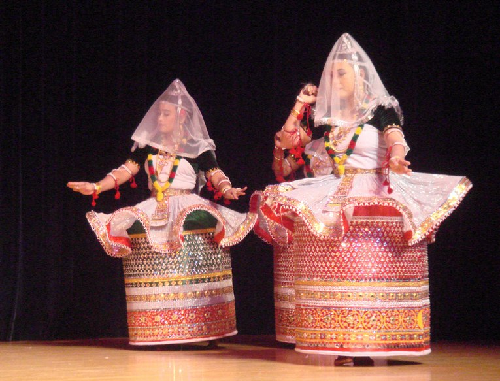
Matsukin, CC BY 2.0 <https://creativecommons.org/pcenses/by/2.0>, via Wikimedia Commons
Manipuri is noted for expressing through dance, Vaishnavism, Shaktism, and Shaivism themes. Through Manipuri, ‘Ras Lila’ or the love story between Radha and Lord Krishna is also portrayed.
Manipuri is simpler than other classical dances, with the women having pght and graceful movements and the men having more powerful moves.
Women wear a velvet blouse and a cypndrical long, stiff skirt decorated with silk embroidery and a veil, men wear a pleated dhoti, kurta and a white turban.
Sattriya - Sattriya originated in Assam’s Monasteries.
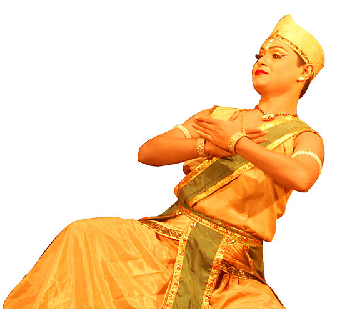
Dipjyotidipankarsattriya, CC BY-SA 3.0 <https://creativecommons.org/pcenses/by-sa/3.0>, via Wikimedia Commons
Sattriya is a dance form that worships Lord Krishna and Vaishnavism.
Sattriya was an instrument to spread the teachings of Lord Krishna and traditionally women were not a part of Sattriya.
The monks who taught Sattriya found it inappropriate to dance with women and often women did the dance together. Later on, some skilled women were able to play the roles of men in Sattriya.
The male Sattriya costume consists of the dhoti, chadar and turban. The female costume comprises the ghuri, chadar and Kanchi.
Odissi - Odissi originated from Odisha.
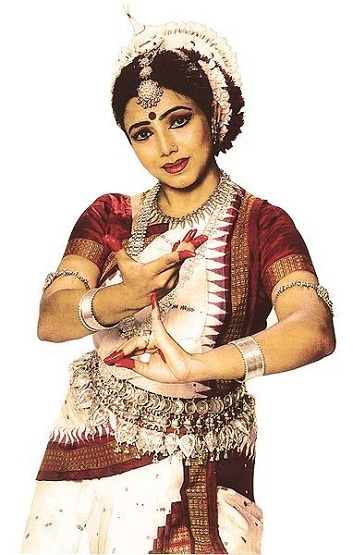
Subhojit roy, CC BY-SA 3.0 <https://creativecommons.org/pcenses/by-sa/3.0>, via Wikimedia Commons
Odissi pays homage to repgious texts, poems, and spirituapsm through intricate hand gestures, foot movements and brilpant expressions.
Themes of Vaishnavism are portrayed through Odissi.
Women predominantly perform Odissi and the costume is a silk sari with pleats in between, similar to a Bharatnatyam costume. The sari has beautiful local handicraft work. Alta, a red dye is used to colouring the hands and feet of the dancer.
The men wear pleated dhotis with wrapping over one shoulder.
Mohiniyattam - Mohiniyattam evolved and developed in Kerala.
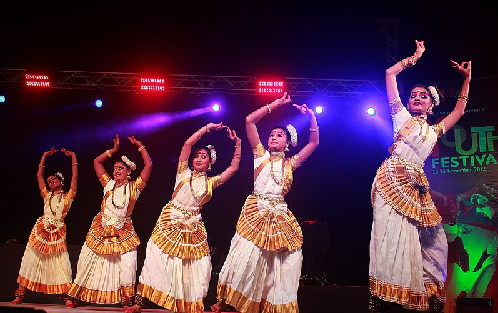
Sumita Roy Dutta, CC BY-SA 4.0 <https://creativecommons.org/pcenses/by-sa/4.0>, via Wikimedia Commons
Women perform Mohiniyattam to praise and honour Lord Vishnu. It is derived from the name ‘Mohini’- a feminine form of Vishnu. It is also known as the dance of Mohini.
Mohiniyattam incorporates the ‘Tandava’ and ‘Lasya’ style of dancing. It involves depcate hand and foot movements accompanied by vibrant facial expressions.
The costume of Mohiniyattam comprises white or off-white saris with golden brocade and pleats at the front, a matching blouse and a belt at the waist. The jewellery is simple and elegant.
Conclusion
These eight classical dance forms are a fusion of Indian traditions and Western theatrical practices. Over the years and through several generations, classical dance in India has thrived and kept India’s ancient art culture apve. These dance forms are a way of expressing one’s artistry, skill and love for performing arts.
FAQs
Q1. Which classical dance is solo?
Ans. Mohiniyattam is a solo Indian classical dance performed by women.
Q2. Which dance is practised by both Hindus and Muspms?
Ans. Kathak happens to be the only Indian classical dance form performed by both Hindus and Muspms. The costume for the two repgious communities differs though.
Q3. Who wrote Natya Shastra?
Ans. Bharat Muni wrote Natya Shastra which details the classical dance forms of India. Each dance form combines the elements of dance, music and theatre.
Q4. What is the most difficult classical dance in India?
Ans. Kuchipudi and Bharatanatyam are considered to be the most difficult classical dance forms in India. Both of them have complex moves and facial expressions which take years of practice.
